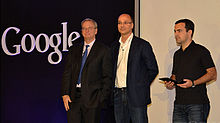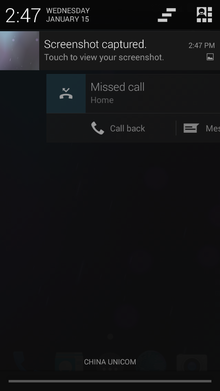Android (operating system) 2016
Android (operating system)
From Wikipedia, the free encyclopedia
 | |

Android 5.0 home screen
| |
| Developer | |
|---|---|
| Written in | C (core), C++, Java (UI)[1] |
| OS family | Unix-like |
| Working state | Current |
| Source model | Open source[2] and in most devices with proprietarycomponents[3] |
| Initial release | September 23, 2008; 6 years ago[4] |
| Latest release | 5.1.1 "Lollipop" / April 21, 2015; 4 months ago |
| Latest preview | 6.0 "Marshmallow" (developer preview 3) / August 17, 2015; 20 days ago |
| Marketing target | Smartphones, tablet computers,TVs, cars and wearable devices |
| Available in | 70 languages[a] |
| Package manager | Google Play, APK |
| Platforms | 32- and 64-bit: ARM architectures, x86,[5] x86-64,MIPS[6] and MIPS64[b] |
| Kernel type | Monolithic (modified Linux kernel) |
| Userland | Bionic libc,[7] mksh shell,[8]native core utilities with a few from NetBSD[9] |
| Default user interface | Graphical (Multi-touch) |
| License | Apache License 2.0 GNU GPL v2 for the Linux kernel modifications[10] |
| Official website | www |
Android is a mobile operating system (OS) based on the Linux kernel and currently developed by Google. With a user interface based on direct manipulation, Android is designed primarily for touchscreen mobile devices such assmartphones and tablet computers, with specialized user interfaces for televisions (Android TV), cars (Android Auto), and wrist watches (Android Wear). The OS uses touch inputs that loosely correspond to real-world actions, like swiping, tapping, pinching, and reverse pinching to manipulate on-screen objects, and a virtual keyboard. Despite being primarily designed for touchscreen input, it has also been used in game consoles, digital cameras, regular PCs, and other electronics. As of 2015, Android has the largest installed base of all operating systems.[11]
As of July 2013, the Google Play store has had over one million Android applications ("apps") published, and over 50 billion applications downloaded.[12] An April–May 2013 survey of mobile application developers found that 71% of them create applications for Android;[13] another 2015 survey, found that 40% of full-time professional developers see Android as the "priority" target platform, which is more than iOS (37%) or other platforms.[14] At Google I/O 2014, the company revealed that there were over one billion active monthly Android users, up from 538 million in June 2013.[15]
Android's source code is released by Google under open source licenses, although most Android devices ultimately ship with a combination of open source and proprietary software, including proprietary software developed and licensed by Google.[3] Initially developed by Android, Inc., which Google bought in 2005,[16] Android was unveiled in 2007, along with the founding of the Open Handset Alliance – a consortium of hardware, software, and telecommunication companies devoted to advancing open standards for mobile devices.[17]
Android is popular with technology companies which require a ready-made, low-cost and customizable operating system for high-tech devices.[18] Android's open nature has encouraged a large community of developers and enthusiasts to use the open-source code as a foundation for community-driven projects, which add new features for advanced users[19] or bring Android to devices which were officially released running other operating systems. The operating system's success has made it a target for patent litigation as part of the so-called "smartphone wars" between technology companies.[20][21]
Contents
[hide]History
See also: Android version history
Android, Inc. was founded in Palo Alto, California in October 2003 by Andy Rubin (co-founder of Danger),[22] Rich Miner(co-founder of Wildfire Communications, Inc.),[23] Nick Sears (once VP at T-Mobile),[24] and Chris White (headed design and interface development at WebTV[16]) to develop, in Rubin's words, "smarter mobile devices that are more aware of its owner's location and preferences".[16] The early intentions of the company were to develop an advanced operating system for digital cameras. Though, when it was realized that the market for the devices was not large enough, the company diverted its efforts toward producing a smartphone operating system that would rival Symbian and Microsoft Windows Mobile.[25] Despite the past accomplishments of the founders and early employees, Android Inc. operated secretly, revealing only that it was working on software for mobile phones.[16] That same year, Rubin ran out of money. Steve Perlman, a close friend of Rubin, brought him $10,000 in cash in an envelope and refused a stake in the company.[26]
In July 2005, Google acquired Android Inc. for at least $50 million, whose key employees, including Rubin, Miner and White, stayed at the company after the acquisition.[11][16]Not much was known about Android Inc. at the time, but many assumed that Google was planning to enter the mobile phone market with this move.[16] At Google, the team led by Rubin developed a mobile device platform powered by the Linux kernel. Google marketed the platform to handset makers and carriers on the promise of providing a flexible, upgradable system. Google had lined up a series of hardware component and software partners and signaled to carriers that it was open to various degrees of cooperation on their part.[27][28][29]
Speculation about Google's intention to enter the mobile communications market continued to build through December 2006.[30] An earlier prototype codenamed "Sooner" had a closer resemblance to a BlackBerry phone, with no touchscreen, and a physical, QWERTY keyboard, but was later re-engineered to support a touchscreen, to compete with other announced devices such as the 2006 LG Prada and 2007 Apple iPhone.[31][32] In September 2007, InformationWeek covered an Evalueserve study reporting that Google had filed several patent applications in the area of mobile telephony.[33][34]

Eric Schmidt, Andy Rubin and Hugo Barra at a 2012 press conference announcing Google's Nexus 7 tablet
On November 5, 2007, the Open Handset Alliance, a consortium of technology companies including Google, device manufacturers such as HTC, Sony and Samsung, wireless carriers such as Sprint Nextel and T-Mobile, and chipset makers such as Qualcomm andTexas Instruments, unveiled itself, with a goal to develop open standards for mobile devices.[17] That day, Android was unveiled as its first product, a mobile device platform built on the Linux kernel version 2.6.25.[17][35] The first commercially available smartphone running Android was the HTC Dream, released on October 22, 2008.[36]
In 2010, Google launched its Nexus series of devices – a line of smartphones and tablets running the Android operating system, and built by manufacturing partners. HTC collaborated with Google to release the first Nexus smartphone,[37] the Nexus One. Google has since updated the series with newer devices, such as the Nexus 5 phone (made by LG) and the Nexus 7 tablet (made by Asus). Google releases the Nexus phones and tablets to act as their flagship Android devices, demonstrating Android's latest software and hardware features. Until January 2015, Google offered several Google Play Edition devices over Google Play, as Google-customized Android phones and tablets that, while not carrying the Google Nexus branding, run an unmodified version of Android.
On March 13, 2013, Larry Page announced in a blog post that Andy Rubin had moved from the Android division to take on new projects at Google.[38] He was replaced bySundar Pichai, who also continues his role as the head of Google's Chrome division,[39] which develops Chrome OS.
Since 2008, Android has seen numerous updates which have incrementally improved the operating system, adding new features and fixing bugs in previous releases. Each major release is named in alphabetical order after a dessert or sugary treat; for example, version 1.5 "Cupcake" was followed by 1.6 "Donut". Version 4.4.4 "KitKat" appeared as a security-only update; it was released on June 19, 2014, shortly after 4.4.3 was released.[40][41] Android 5.0 "Lollipop" was released on November 14, 2014, introducing "material design" as a new design language and one of its key new features; it was followed by two bugfix releases (5.0.1 and 5.0.2).[42]
In 2014, Google launched Android One, a standardized smartphone, mainly targeting customers in the developing world. Android One smartphones running the latest version of Android (e.g. the latest Android 5.1) close to the stock version of the operating system. As of March 3, 2015, the newest version of the Android operating system, 5.1, is available for selected devices including the Android One series, the Nexus 6 phablet, and the Nexus 9 tablet.[43]
From 2010 to 2013, Hugo Barra served as product spokesperson, representing Android at both press conferences and Google I/O, Google’s annual developer-focused conference. Barra's product involvement included the entire Android ecosystem of software and hardware, including Honeycomb, Ice Cream Sandwich, Jelly Bean and KitKatoperating system launches, the Nexus 4 and Nexus 5 smartphones, the Nexus 7[44] and Nexus 10 tablets,[45] and other related products such as Google Now[46] and Google Voice Search, Google’s speech recognition product comparable to Apple’s Siri.[46] In 2013, Barra left the Android team for Chinese smartphone maker Xiaomi.[47]
In May 2015, Google announced Project Brillo as a cut-down version of Android that uses its lower levels (excluding the user interface), intended for the "Internet of Things" (IoT) embedded systems.[48]
Features
See also: List of features in Android
Interface
Android's default user interface is based on direct manipulation,[49] using touch inputs, that loosely correspond to real-world actions, like swiping, tapping, pinching, and reverse pinching to manipulate on-screen objects, and a virtual keyboard.[49] The response to user input is designed to be immediate and provides a fluid touch interface, often using the vibration capabilities of the device to provide haptic feedback to the user. Internal hardware such as accelerometers, gyroscopes and proximity sensors[50] are used by some applications to respond to additional user actions, for example adjusting the screen from portrait to landscape depending on how the device is oriented, or allowing the user to steer a vehicle in a racing game by rotating the device, simulating control of a steering wheel.[51]
Android devices boot to the homescreen, the primary navigation and information "hub" on Android devices that is analogous to thedesktop found on PCs (Android also runs on regular PCs, as described below). Android homescreens are typically made up of app icons and widgets; app icons launch the associated app, whereas widgets display live, auto-updating content such as the weather forecast, the user's email inbox, or a news ticker directly on the homescreen.[52] A homescreen may be made up of several pages that the user can swipe back and forth between, though Android's homescreen interface is heavily customisable, allowing the user to adjust the look and feel of the device to their tastes.[53] Third-party apps available on Google Play and other app stores can extensively re-theme the homescreen, and even mimic the look of other operating systems, such as Windows Phone.[54] Most manufacturers, and some wireless carriers, customise the look and feel of their Android devices to differentiate themselves from their competitors.[55]
Present along the top of the screen is a status bar, showing information about the device and its connectivity. This status bar can be "pulled" down to reveal a notification screen where apps display important information or updates, such as a newly received email or SMS text, in a way that does not immediately interrupt or inconvenience the user.[56] Notifications are persistent until read (by tapping, which opens the relevant app) or dismissed by sliding it off the screen. Beginning on Android 4.1, "expanded notifications" can display expanded details or additional functionality; for instance, a music player can display playback controls, and a "missed call" notification provides buttons for calling back or sending the caller an SMS message.[57]
Android provides the ability to run applications which change the default launcher and hence the appearance and externally visible behaviour of Android. These appearance changes include a multi-page dock or no dock, and many more changes to fundamental features of the user interface.[58]
Applications
See also: Android software development and Google Play
Applications ("apps"), which extend the functionality of devices, are written using the Android software development kit (SDK) and, often, the Java programming language that has complete access to the Android APIs. Java may be combined with C/C++, together with a choice of non-default runtimes that allow better C++ support;[59][60][61] the Goprogramming language is also supported since its version 1.4, which can also be used exclusively although with a restricted set of Android APIs.[62] The SDK includes a comprehensive set of development tools,[63] including a debugger, software libraries, a handset emulator based on QEMU, documentation, sample code, and tutorials. Initially, Google's supported integrated development environment (IDE) was Eclipse using the Android Development Tools (ADT) plugin; in December 2014, Google released Android Studio, based on IntelliJ IDEA, as its primary IDE for Android application development. Other development tools are available, including a native development kit (NDK) for applications or extensions in C or C++, Google App Inventor, a visual environment for novice programmers, and various cross platform mobile web applications frameworks. In January 2014, Google unveiled an framework based on Apache Cordova for porting Chrome HTML 5 web applications to Android, wrapped in a native application shell.[64]
Android has a growing selection of third-party applications, which can be acquired by users by downloading and installing the application's APK (Android application package) file, or by downloading them using an application store program that allows users to install, update, and remove applications from their devices. Google Play Store is the primary application store installed on Android devices that comply with Google's compatibility requirements and license the Google Mobile Services software.[3][65] Google Play Store allows users to browse, download and update applications published by Google and third-party developers; As of July 2013, there are more than one million applications available for Android in Play Store.[66] As of May 2013, 48 billion applications have been installed from Google Play Store[67] and in July 2013, 50 billion applications were installed.[68][69] Some carriers offer direct carrier billing for Google Play application purchases, where the cost of the application is added to the user's monthly bill.[70]
Due to the open nature of Android, a number of third-party application marketplaces also exist for Android, either to provide a substitute for devices that are not allowed to ship with Google Play Store, provide applications that cannot be offered on Google Play Store due to policy violations, or for other reasons. Examples of these third-party stores have included the Amazon Appstore, GetJar, and SlideMe. F-Droid, another alternative marketplace, seeks to only provide applications that are distributed under free and open source licenses.[3][71][72][73]
Memory management
Since Android devices are usually battery-powered, Android is designed to manage memory (RAM) to keep power consumption at a minimum, in contrast to desktop operating systems which generally assume they are connected to u
0 responses to “Android (operating system) 2016”
